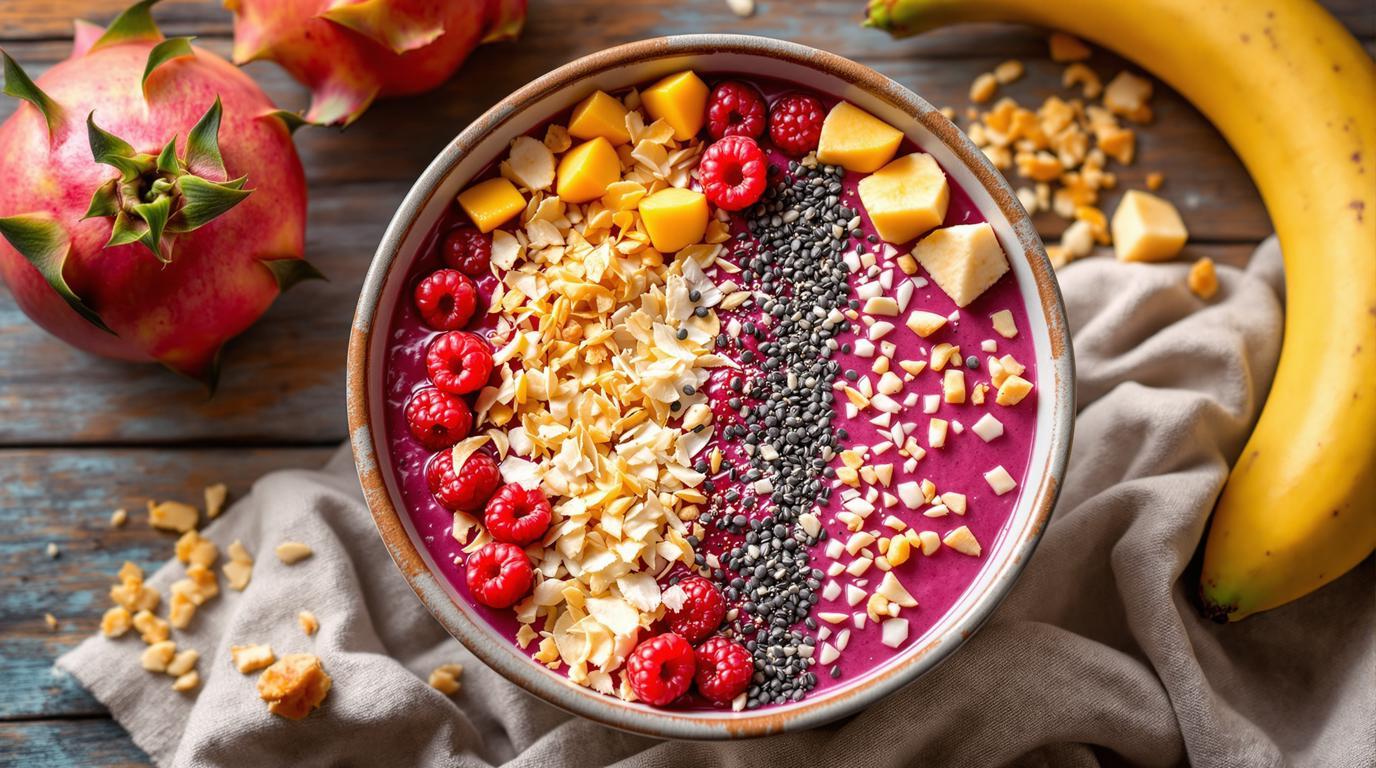The first time I encountered a dragonfruit in my grandmother’s kitchen, I was captivated by its exotic appearance. “It looks like it’s from another planet,” I remember saying as a young culinary student. Her weathered hands expertly sliced the vibrant pink skin to reveal speckled white flesh. “In Vietnam,” she told me, “they believe this fruit cools the body from within.” That afternoon, long before smoothie bowls became trendy, we created a simple fruit medley that would later inspire my restaurant’s signature dragonfruit bowl. What makes this dish special isn’t fancy equipment or complex techniques—it’s the celebration of fresh, vibrant ingredients prepared with mindful attention to flavor and texture.
The Magic of Traditional Dragonfruit Bowls 🌱
Dragonfruit bowls aren’t merely Instagram-worthy breakfasts; they’re a contemporary interpretation of how tropical fruits have been enjoyed for generations across Southeast Asia, Central America, and the Caribbean. What sets a traditional-style preparation apart is restraint—allowing the natural flavors to shine without overprocessing or excessive sweeteners. The dragon fruit (pitaya) itself originated in Central America before Spanish traders introduced it to the Philippines and eventually throughout Asia, where it became deeply integrated into culinary traditions.
Unlike modern smoothie bowls that rely heavily on frozen ingredients and high-powered blenders, our grandmother-inspired version embraces simplicity, using just-ripe fresh fruits and minimal dairy. This approach honors how dragonfruit might have been prepared before electricity became commonplace in tropical kitchens around the world.
Essential Ingredients for Authentic Flavor 🧾
For two generous servings, you’ll need:
- 1 medium ripe dragonfruit (about 1 cup flesh), chilled
- 1 medium ripe banana
- 1 cup fresh mango, diced (about 1 medium mango)
- 2 tablespoons full-fat coconut milk
- 4-6 ice cubes
- For toppings: toasted coconut flakes, fresh berries, crushed nuts, or chia seeds
When selecting dragonfruit, look for slight give when gently pressed—similar to a perfect avocado. The skin should show slight pink spottiness, indicating optimal ripeness. If you can’t find dragonfruit locally, a combination of 1 cup frozen pineapple with 1/4 cup beet juice provides a similar color and texture. For a rainbow smoothie bowl effect, consider adding additional fruits for vibrant color layers.
Grandmother’s Method 📝
1. Carefully slice the dragonfruit in half and scoop out the flesh with a spoon. Cut into chunks and place in your blender.
2. Add banana chunks, diced mango, coconut milk, and ice cubes to the blender.
3. Pulse gently until ingredients are just combined—about 30-45 seconds. Resist the urge to over-blend; traditional preparations maintain some texture rather than completely smooth consistency.
4. Pour into shallow serving bowls immediately.
5. Arrange your chosen toppings in a visually pleasing pattern, creating sections rather than mixing everything together.
Chef’s Note: The difference between a good dragonfruit bowl and an exceptional one lies in the ripeness of your fruit. Underripe dragonfruit lacks sweetness, while overripe fruit becomes mushy. When perfectly ripe, dragonfruit offers subtle sweetness with kiwi-like notes that complement the tropical punch of mango beautifully.
Secret Techniques from Tropical Kitchens 🤫
Traditional dragonfruit preparations often include a textural element to contrast the smooth base. In Vietnam, you might find sticky rice alongside fresh fruit; in Caribbean preparations, a sprinkle of lime zest adds brightness. For an autumn-inspired twist, consider adding warming spices like cinnamon or cardamom.
The biggest mistake home cooks make is diluting the mixture with too much liquid. Unlike Western smoothies, traditional fruit bowls maintain a thicker consistency—almost spoonable rather than drinkable. Start with just 2 tablespoons of coconut milk and add more only if absolutely necessary to achieve blending.
Serving & Cultural Significance 🍽️
In Southeast Asia, dragonfruit is traditionally served as a cooling respite from tropical heat. Pair your dragonfruit bowl with fresh coconut water for an authentic experience, or consider a poke bowl for a complete meal inspired by Pacific island cuisines.
For a complete dining experience, consider serving small portions of this dish after a satisfying main course like Belgian-style mussels or Mediterranean protein soup—the bright, refreshing flavor provides perfect contrast to savory dishes.
Each bite offers not just delicious flavor but significant nutritional benefits: dragonfruit contains immune-boosting vitamin C, while mango provides fiber and banana adds potassium. The entire bowl delivers approximately 220-250 calories with 5-6g of fiber and just 2-3g of protein—making it an ideal light breakfast or afternoon refreshment.
As I prepare this dish in my restaurant kitchen today, I’m transported back to my grandmother’s wooden table, where she taught me that the most memorable food isn’t about complexity but about honoring ingredients with proper handling and respectful preparation. I hope this traditional-style dragonfruit bowl brings a touch of tropical heritage to your table, wherever you may be.
